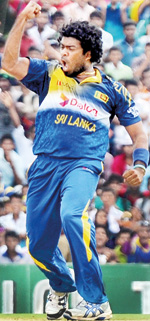Is Malinga an over-the-hill icon?
View(s):Who’s afraid of Virginia Wolf? Though this is just a pun on Edward Albee’s 1962 play about a breaking up of a marriage, my narration is based upon the breaking down of an icon who is gradually fudging himself to zero.
 When Lasith Malinga first broke into the international arena from almost total obscurity, he just walked into stardom. He was different to the other fast bowlers in the international circuit. He was comparatively short and hailed from the Indian-sub continent. Yet, he could deliver the ball at speeds of over 140kms and had a deadly yorker. But, above all, he was different. His sling arm delivery left his arm in front of the umpires’ chest and most of the batsmen could not pick him up.
When Lasith Malinga first broke into the international arena from almost total obscurity, he just walked into stardom. He was different to the other fast bowlers in the international circuit. He was comparatively short and hailed from the Indian-sub continent. Yet, he could deliver the ball at speeds of over 140kms and had a deadly yorker. But, above all, he was different. His sling arm delivery left his arm in front of the umpires’ chest and most of the batsmen could not pick him up.
Then as his fame and stock went up, the ‘Goldilocks’ also began to appear on his cranium. From a back street lad from the backwoods of Galle, Malinga became an international trend setter and the four wickets in four balls against South Africa in a World Cup match in the West Indies blasted his international image out of proportion.
 For a player who hit the mainstream direct from the backwoods, Malinga had an inborn insight into the game and before long, he developed some deliveries that took him to the pedestal of the fast bowling art, specialising in the T-20 format of the game.
For a player who hit the mainstream direct from the backwoods, Malinga had an inborn insight into the game and before long, he developed some deliveries that took him to the pedestal of the fast bowling art, specialising in the T-20 format of the game.
Malinga began to dominate the T-20 segment, and soon became one of the main stays of the Indian IPL franchise Mumbai Indians. So much so, when I was in Mumbai for the 2011 World Cup, one of the Hotel employees wanted to know if I was from Kerala. I told him that I hailed from Sri Lanka “Oh! From Malinga country, good!” he said.
Like any fast bowler he had his own share of injuries too. However, this situation along with his own personal implications saw him giving up representing his country in the Test segment. Nonetheless this came at an unwelcomed moment – the era that the Lankans were groping in the dark after the retirement of Muttiah Muralitharn and Chaminda Vaas. Besides, he represented the country also in starts and stutters owing to injury.
May be, he was concentrating more on the T-20. Gradually, his performances even in the 50-over format began to dwindle. Yet, the ankle injury that he aggravated while taking part in the 2014 IPL Championship tournament, stayed with him longer than expected and by the latter part of the 2014, he had to give way for medication and the expected comeback.
In the past 12 months or so, Malinga’s last fiery spell of match winning fast bowling performance for Sri Lanka came on July 9, last year at Pallekele against South Africa where he bagged 4 for 24 in just six overs. However, in the very next match the visitors turned their backs on the speedster by whacking him for 85 runs in his allotted ten overs and he failed to get a wicket, too. Thereafter, his best performance came on August 30 last year where he bowled 1 for 17 in seven overs against Pakistan at Dambulla.
When the Englishmen came to Sri Lanka for an ODI series by the year-end, Malinga was on leave mending his injury.
Leaving for New Zealand, the Lankans were in for a surprise. The flightless Kiwis were like an angry pack of bees full of sting in the pre-world cup ODI series. The Lankan waited for Malinga to come out of injury to teach the naughty Kiwis a lesson or two, but, the Lankan icon went for a wicketless 84 runs in his ten overs in his first match in New Zealand and the Lankans forgave the fast bowler because he was just coming out of an injury.
Just prior to the World Cup, troubled waves began to hit the Lankan ship when head-coach Marvan Atapattu demanded the immediate removal of the Lankan fast bowling coach Chaminda Vaas, and wanted him replaced by former fast bowling coach Champaka Ramanayake. However, Ramanayake declined to go and Vaas stayed on till the end of the World Cup – almost sidelined.
Delving into the matter we discovered that what really had gone wrong were the woeful working relationships some fast bowlers like Lasith Malinga and Thisara Perera had with the Lankan fast bowling coach.
The charge against Vaas was about the discipline of the Lankan fast bowling unit. Now it is sometime that Chaminda Vaas had left the Lankan coaching realms. Yet, one cannot see any improvement in the Lankan bowling fortunes – especially in the fast bowling department where the most experienced bowler Lasith Malinga leads the pack.
Malinga during the last one year has played 20 ODIs and bagged twenty wickets at a cost of 38.27 per wicket — for the best death bowler in the world, certainly it is not good enough. He is the leader of the pack. Malinga is the bowler that his captain could throw the ball when the team is pushed into a tight corner. Yet, on Wednesday, he bowled his first maiden over after nine international matches for the country. Yet, in the inning he bagged only one wicket and went for more than six runs per over in the rest.One of the insiders quipped, “Yes, he is in the process of overcoming his ankle injury, but there is no reason for him to slack in his training regime. He hardly even does the treadmill — leave the strenuous part alone.
“He is trying to survive on his reputation and variations. But, when you are under trained there is a certain build-up of lactic acid in your system which makes you feel tired and keeps you away from performing at your peak.”
He went on to explain that Malinga is not the only flouter of this training regime. When those faults are brought to the notice of the persons that matter, the issues become national affairs because the players concerned are modern-day icons. “Then the players seek the intervention of those in high pedestals and on most occasions they get away with it. The cascading result is the coaching staff and the selectors lose control of the players. That is the dangerous aspect of this whole episode. Then even the selectors get the wrong end of the handle. Then the pressure that is built has to find its own vent to relieve itself and may be the result is that the wrong heads begin to roll.”
What we see at this end is that this is not a phenomenon that developed overnight. Sometimes even the captains are responsible for this situation, because there are instances where captains themselves have asked for players over-the-hill and there have been huge inside tussles. If one is a senior, he should perform like a senior and be someone that the younger brood could look up to. If there is no cue to be taken, even the icon may not know when he would be dumped on a highway in the middle of nowhere.


